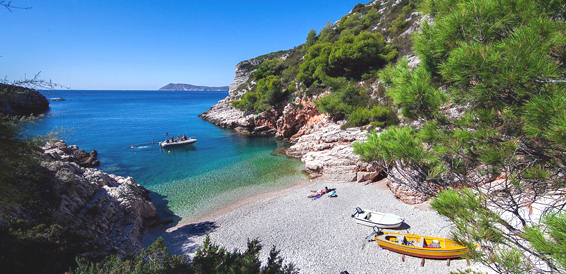
Southern Dalmatia
Whenever you speak or think of Southern Dalmatia, one cannot but think about Dubrovnik, since this is the first image that comes to mind. There is a good reason for this. Dubrovnik, the capital of this warm region, an independent principality in the past, is one of the most beautiful towns in Europe and one of the few that were never conquered. It is surrounded by city walls, first built in the 12th century, with churches, palaces, monuments, monasteries and museums that could easily take a whole year to discover. The old town is a labyrinth of streets paved in white flagstones, which have, over the course of hundreds of years, been polished to a shine by people’s feet. Long and narrow allies carved with hundreds of steps descending from the city walls are very lively, packed with bars, shops and galleries and crowded with people. In 1979, the old city of Dubrovnik, which includes a substantial portion of the old walls of Dubrovnik, joined the UNESCO list of World Heritage Sites.. The town of Ston was a major fort of the Republic of Dubrovnik and its defensive walls are regarded as a notable feat of medieval architecture. The town's inner wall measures 890 metres in length, while the Great Wall outside the town has a circumference of 5 km. The walls extend to Mali Ston, a smaller town on the northern side of the Peljesac isthmus and the end of the Bay of Mali Ston, notable for its mariculture. Ston is also known for its saltworks which were run by the Republic of Dubrovnik and the Ottoman Empire. But there is more to the region, much more. It also includes the picturesque archipelago Elafiti, the sun-bathed Peljesac Peninsula, the islands of Korcula and Mljet. Separated from the rest of Croatia by a 4 km long stretch of Bosnian coast around Neum where there are no restrictions of passage, Southern Dalmatia, for all intents and purposes, appears to be joined to Central Dalmatia.
Southern Dalmatia, particularly the Peljesac Peninsula, the second biggest peninsula in Croatia, is a good wine growing region, and many of the wines from the region have now acquired worldwide renown. The region also produces a large part of Croatia’s oranges, figs and olives, and it is very common to see those for sale by the roadside in the north part of the province. Peljesac was recognized as a place of special beauty even back in the time of the Austro-Hungarian Empire, when it was declared a Nature Park and put under special protection by the king himself. The small island of Lokrum, just a short sail from Dubrovnik, has many beautiful beaches you certainly should visit and a lovely promenade where you can stroll by the exuberant vegetation on the way to the Royal Fort, a reminder of the Napoleon's occupation. Stroll your feet down fine pebble and sand beaches as you wade in the sky-blue crystal sea. A place of particular beauty is the island of Mljet, lying southwest of Dubrovnik, unique for its heavenly beautiful nature. The northern part of the island is a national park with two deep bays which are referred to as lakes because of their very narrow outlets to the sea. With lush and diverse Mediterranean vegetation, the park is also home to valuable antique monuments and a 13th century Benedictine monastery set upon an islet in the middle of the lake.
Separated from Peljesac by only a narrow strait, the island of Korcula bears witness to ancient times, going back to the 12th century BC when the town of Korcula was founded by the Trojan hero Antenor. The world-famous sailor and trader Marco Polo was born here, too. The fascinating thing about Korcula is that its coast is as rich and diverse as its history is!
Equally admirable is the cuisine of the region. The taste of fresh fish, shellfish and crab and the scent of wild grown herbs will get you addicted in no time. Fresh oysters from Ston sprinkled with homegrown lemon juice are a delight to taste, and are famous for their aphrodisiac properties. The perfect blend of wind and sun play a major role in the quality of local wines, greatly appreciated around the world.
The southernmost region of Croatia, Southern Dalmatia is known for the deepest sea (1233 m at its deepest point), sheerest cliffs, richest marine life and the hottest, yet not driest Mediterranean climate in Dalmatia. The area south of Mljet has only a few islands and is open towards the Mediterranean sea, which contibutes to the strength of jugo and the height of the waves.
The unique configuration of landscape surrounding the Korcula channel, in collaboration withthe summer wind maestral, creates the Venturi effect, making the area world-famous for wind surfing, kitesurfing and sailing. Bura is usually the strongest in the Peljesac peninsula area, with the highest intensity near the foothills of the Sv. Ilija peak, where short-term weather condition changes are possible.
Over the year, especially during summer, the weather in Southern Dalmatia is hot and dry, with light up to mild winds blowing, making it a perfect region for sailing and vacation!